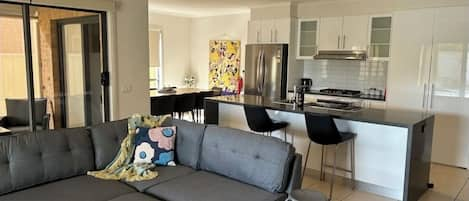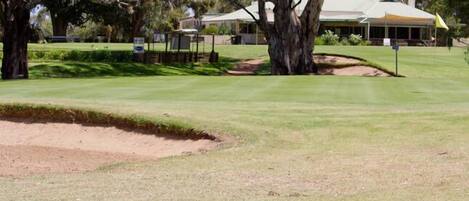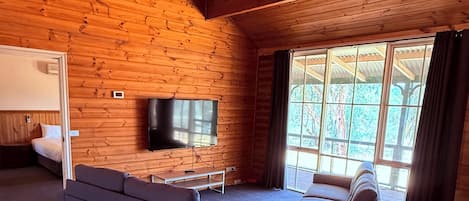Unique property that was awarded recognition in 2012 from the Australian Institute of Architects for Residential Alterations and Extensions and later featured in the television series "Sacred Spaces", Wattle Avenue House has become a celebrated beacon of architecture in Mildura and one of incredible transformation.
Positioned in a wide tree-lined street and centered within the city's cultural hub of cafes, restaurants, galleries and recreation, this home is an example whereby its exceptional living spaces match up to its exceptional location. Cruise along the nearby Murray, wander across to the Marina, or enjoy one of the many nearby eateries in town, all of which are within a short comfortable stroll. Alternatively, explore the nearby wineries, breweries and fresh produce farms all of which this bounteous region is so renowned for.
A prized location however is just the beginning of this unparalleled offering. It has been sympathetically renovated to create an effortlessly flowing floorplan with zoned areas that each enjoy a pleasant outlook to the outdoors. Upon entering there is an instant feeling of sophisticated, homely nostalgia unlike any other with natural light spilling in from all angles, including the clerestory windows which expand the entire length of the house. An internal glass courtyard with sliding doors connects the main living, dining and perfectly appointed kitchen that is fit for a chef (literally), boasting premium quality European appliances, spacious walk-in pantry, large double sinks and stainless-steel bench tops. This is all favorably orientated to the northeast and truly claims the heart of the home. A spacious deck and rear yard abundant with fresh produce and immaculately kept gardens. Here is the ideal place to gather with family and friends or simply sit and watch the glorious sunset on a warm, balmy night.
Wattle Avenue House Bed & Breakfast is a 3 bedroom, 2 bathroom home, with gourmet chef kitchen, Wine Dellar, Study, Media Room and much more. Awarded 2012 Architectural award alteration and refurbishment.
Wattle Avenue House Bed & Breakfast allows you to experience this unique accommodation offering all within easy walking distance of Mildura’s famed “Eat Street” and the beautiful Murray River foreshore.
Wattle Avenue House project:
A special Our Houses public talk was held on 25 October 2012 as part of the 2012 Melbourne Architecture Annual themed – community and architecture – with the architect and clients discussing the making of the Wattle Avenue House. Presented by Houses magazine, Our Houses is a series of informal public talks about the creation of domestics spaces.
"....A suburban house in Mildura becomes a talking point thanks to an intervention by Minifie van Schaik architects.
A waiter bringing the menu to Luciano Pavarotti at a restaurant – so the anecdote goes – was rebuked by the flamboyant tenor, who exclaimed: “A menu! I don’t want a menu: I want food.” I can imagine a similar conversation between the charismatic de Pieri family in Mildura, north-western Victoria, and a real estate agent keen to show them some prestige landmark property beside the Murray River. “We don’t want a riverside landmark property. We want a house.”
It doesn’t follow, however, that any old house will do, just as Pavarotti wouldn’t have wanted any old food – even if it did start with the principle of good cuisine: a basic ingredient. When designing for the de Pieri family, Jan van Schaik of Minifie van Schaik Architects began with just that: the basic ingredient being an “any old house” with an undistinguished horizontal cream brick veneer.
The pre-existing house, standing unaffected on its quarter-acre block, was put in the mix like some honest but unprepossessing vegetable – a good spud, already peeled and par-boiled. In short order, the bland brick veneer would get transformed into something exquisite: a culinary and bookish sanctuary for the energetic organizer of the Mildura Writers Festival, Donata Carrazza, her husband, the philosopher-chef Stefano de Pieri and their two gregarious children of university age.
Scorn for the brick veneer was never on Jan’s mind; and something about the bald but friendly blandness must have appealed to the de Pieri family for them to have bought it in the first place. It is, after all, a quintessentially suburban Australian home, an unsung icon of luxury-to-scale, an economical manor on a miniature estate, which few countries in the world have the space to afford for the bulk of people.
Brick-veneer houses have vernacular charm and as much formality or “laid-backness” as you put into them. A brick veneer is familiar to us both as a stuffy, lifeless vitrine containing lace curtains and rococo furniture and also as a run-down joint crowded with dogs, trailers and an engine block standing on bricks on the porch.
Rather than negate this lively inclusiveness, Jan finds a way to heighten its allure. He achieves it by visiting a remarkable contemporary gesture on the southern side, where a garage might normally stand. The exterior has a geometric horn with an echo of Le Corbusier’s Ronchamp Chapel, rising proudly in white hexagonal tiles as a portion of an icosahedron.
In the internal spaces, the contrast between the original home and the new addition is most clearly played out. Pride of place is given to a large kitchen, which is now the focus of the old structure. The new chapel, as I think of it, contains both spacious and intimate areas devoted to library and music spaces. New and old structures share a courtyard, flanked on the adjacent side by the continuation of the chapel, which turns into a workstation and terminates in the main bedroom.
The kitchen is large enough not to require cupboards over the benchtops, which allows visual flow between the study quarters, cooking spaces and the dining table. The light throughout these spaces is carefully controlled, moving from the brightness of the culinary parts to the light-sheltered recesses of the library, with the glare of Mildura filtered by shaded clerestory windows and an enclosed courtyard.
Very little of the old house had to be changed because most of it was functional and well crafted. It only lacked a relationship with art and culture. Jan has rehabilitated the old house for its practical genius but doesn’t ask it to perform any transcendental functions, which are left to the new monastic parts. His process of redeeming the old house was the opposite of a typical Victorian renovation, where a grave and stately front end typically dissolves in a slick and snazzy extension at the back.
Symbolically, the junction of new and old is set out in the facade, which scans like a visual story. In the abstract language of architecture, it’s like a painting of the Annunciation, where an angel has swooped in from the left to visit the Virgin Mary and bring her the news of new fertility. It seems fitting that this scenario, surrounded by a hedge of olive trees, should present its drama to the street diagonally opposite St Joseph’s College.
Although the house doesn’t pretend to be homogeneous – rather, postmodern inclusiveness is triumphant – it has rich continuities among the disparate origins. A neat stylistic protocol draws the otherwise distinctive spaces together. Especially impressive is the way that the spaces wander from the open to the intimate, which makes for a settled mood. It’s a house where you could write a book or invent a dish, a place of generous vistas but also nooks and corners that episodically relate to one another.
On the outside, the property speaks to Mildura in its own language, with its unmistakable brick vernacular. But it also signals another life, full of conversation, contrast and savour, where nothing tasteless would ever be on the menu.














